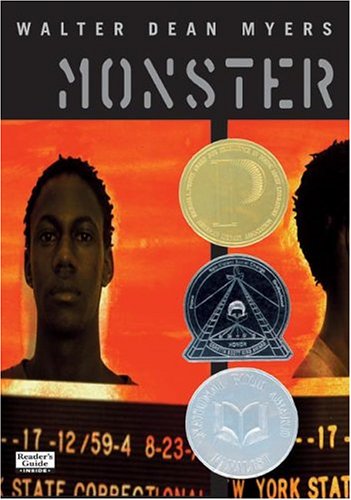It has taken me longer than it should have to get around to
reading Walter Dean Myers’ Monster. I
was recently doing some research on young adult books that combine both text
and image, and Monster was referenced
a few times because of the black and white photographs interspersed throughout.
Monster won the first Prinz Award
when the award was created in 2000, and the experimental and challenging format
it engages with represented the kind of book that the Prinz Award wanted to
recognize.
Monster uses a
screenplay format to tell the story of Steve Harmon, a sixteen-year-old boy who
is on trial for the murder of a man, Alguinaldo Nesbitt, who owned a drug store
in Harlem. Harmon is implicated in the crime by a series of criminals who are
trying to lessen their sentences by cooperating with the police. On trial,
awaiting his sentencing as the “look-out” in the hold-up, Harmon writes his
story in screenplay form, his interest in films becoming more apparent as the
novel progresses. The screenplay is
interspersed with journal entries, as Harmon must return to his prison cell
during the downtime of his trial.
As a sixteen-year-old in jail, Harmon is in a constant state
of fear and anxiety. He begins his narrative by writing, “The best time to cry
is at night, when the lights are out and someone is being beaten up and
screaming for help. That way even if you sniffle a little they won’t hear you.
If anybody knows that you are crying, they’ll start talking about it and soon
it’ll be your turn to get beat up when the lights go out.” He has been in jail
for “a few months” but is not nearly close to getting used to the routine of
imprisonment. He decides to record the trial as a screenplay, since he has been
involved in a film club at his school and views the world through camera
angles, close-ups, and voiceovers. He is also writing as a way of
self-definition, particularly to find out who is his and what he has done. He
writes of his story, “I’ll write it down in the notebook they let me keep. I’ll
call it what the lady who is the prosecutor called me. Monster.”
The reader is introduced to the prosecutor, the defense, the
judge, and the jury. They are a dramatic list of characters at the beginning of
the screenplay, followed by the opening credits that Harmon figures to the
style of Star Wars, an indication of
both his age and interests. Spliced between the real-time trial are scenes that
attempt to carve out Harmon’s character: him and his younger brother Jerry
talking about superheroes; his film class; his friends.
There are also black and white photographs throughout, all
of them apparently of Harmon. The lack of color functions as a means of reading
Harmon’s trial as subsisting in a morally grey zone; his innocence is not so
black and white as the portrait photographs that appear in the book. Harmon
grapples with his participation in the holdup; even though he was just the
look-out, casing the drug store and making sure there were no obstacles in the
way, Nesbitt still was murdered. He talks to other prisoners in jail who take
responsibility for their crime, anticipating “guilty” verdicts and connecting
them innately to the crime they committed. Harmon, however, is different. He
can’t grapple with the moral uncertainty of his crime. He didn’t pull the
trigger, but he was involved, even peripherally, in murder. He represents the
facts of the trial in an unflinching account of witnesses and cross-examinations,
but there is still a sense of uncertainty about what Harmon’s verdict will be,
and his own moral dilemma.
As the book neared the end, I was actually getting worried
that the verdict wouldn’t be revealed, and that Myers’ would leave the novel
hanging on the same uncertainty that threads throughout the story. Luckily, there
is no such ambiguity, although I’m not sure if this does anything to lessen the
uncertainty, or Harmon’s own sense of morality and accountability. The last few
lines of the book hold the reader in a sense of ambivalence, as Harmon
struggles to define who he is: “I want to look at myself a thousand times to
look for one true image. When Miss O’Brien looked at me…what did she see that
caused her to turn away? What did she see?”
I would not recommend leaving Monster unread. For its innovative form, its ambiguous subject, and
Harmon’s unflinching voice, it is certainly a book worth reading.





No comments:
Post a Comment